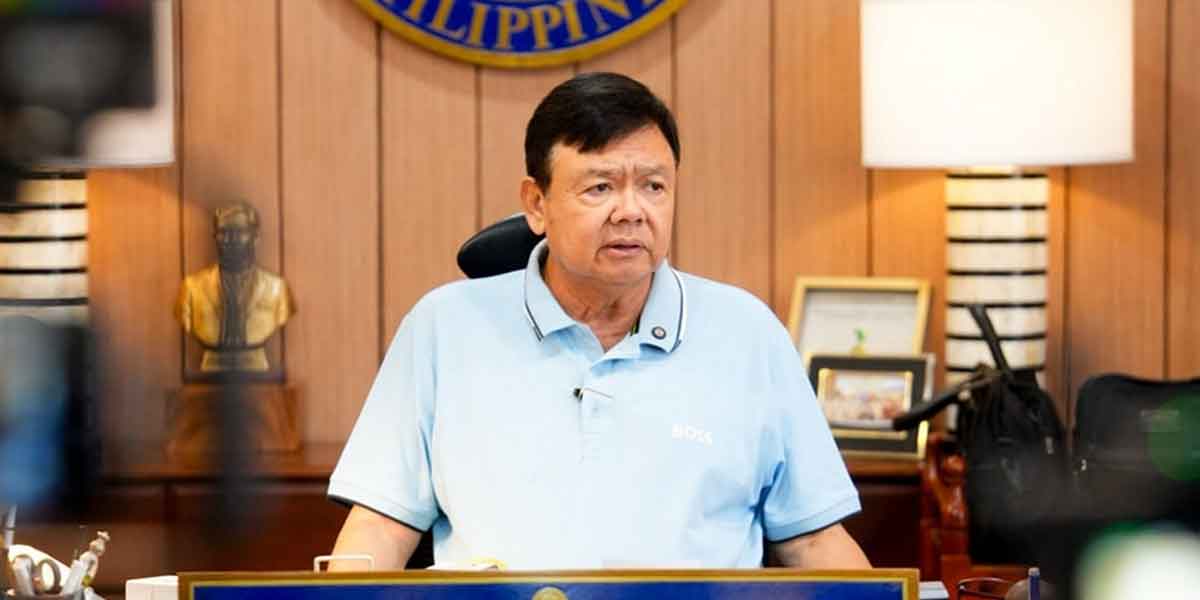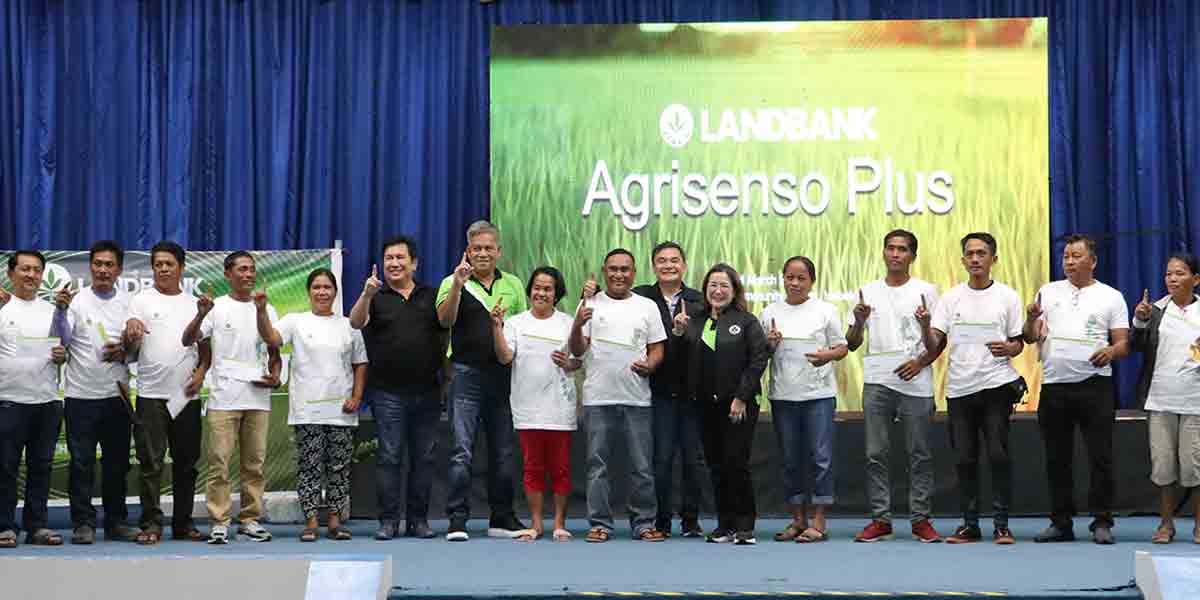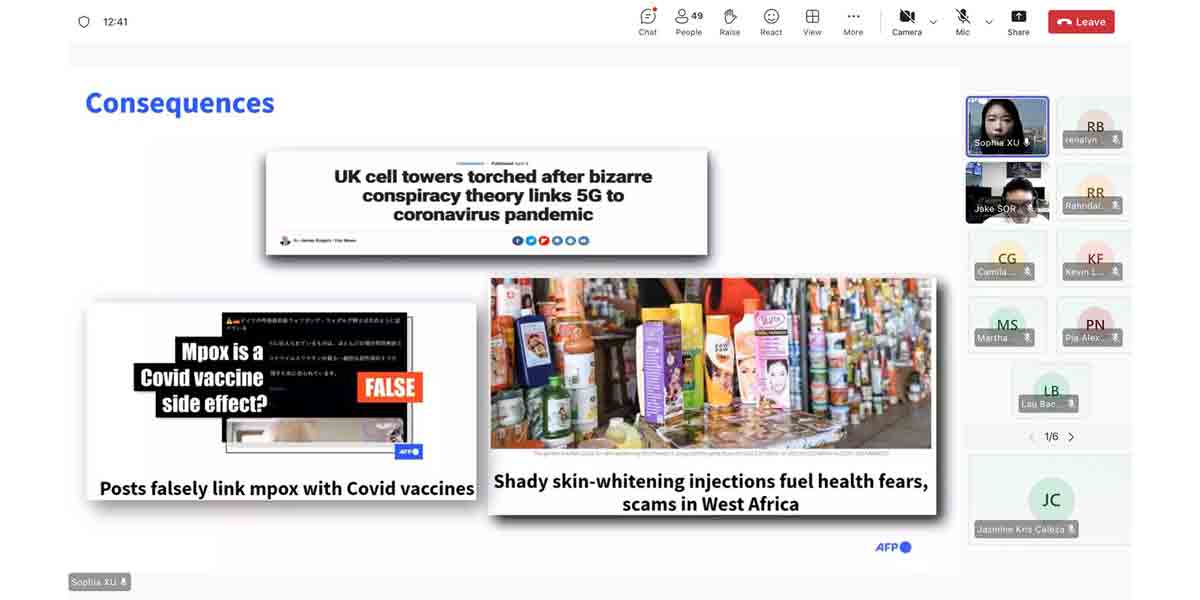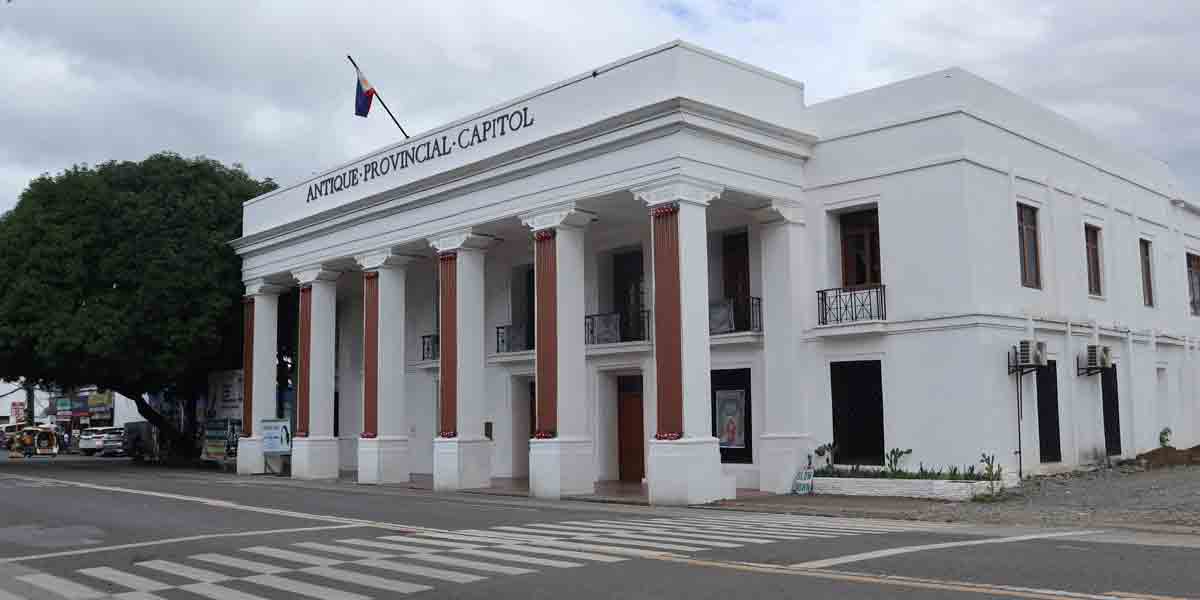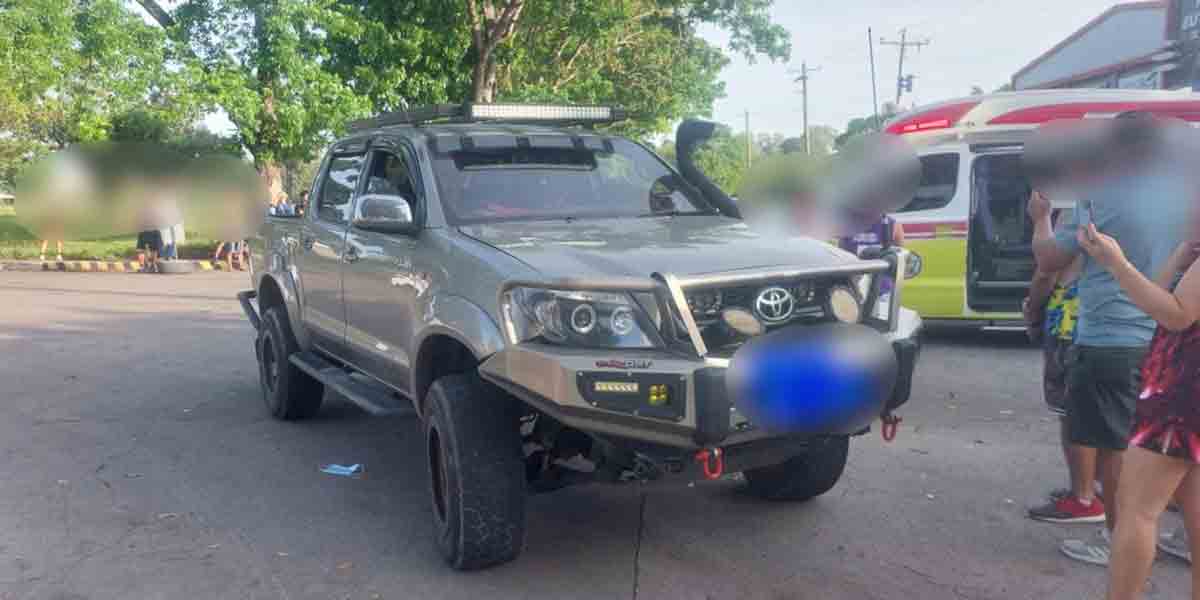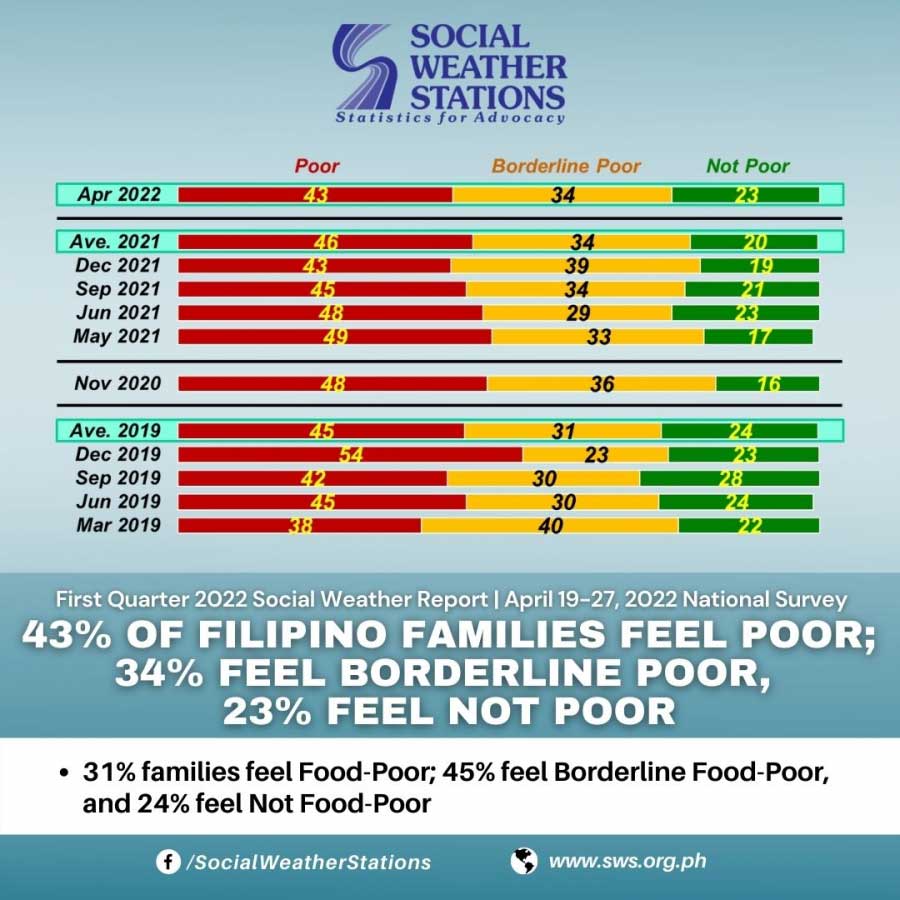
By Francis Allan L. Angelo
Social Weather Stations’ (SWS) latest non-commissioned survey released on Wednesday indicated that almost half of Filipino families said they feel poor amid the COVID-19 pandemic and rising fuel prices.
The national Social Weather Survey, which was conducted April 19-27, 2022, indicated that 43% of 1,440 interviewed adults rated themselves as Mahirap or Poor while 34% saw themselves as Borderline Poor (by placing themselves on a horizontal line dividing Poor and Not Poor).
Also, 23% rated themselves as Hindi Mahirap or Not Poor.
These levels are similar to those surveyed in December 2021, when 43% felt Poor, 39% felt Borderline Poor, and 19% felt Not Poor, according to the SWS.
The estimated numbers of Self-Rated Poor families are 10.9 million in April 2022 and 10.7 million in December 2021.
SWS measured Self-Rated Poverty (SRP) quarterly by face-to-face (F2F) surveys ever since 1992, except in the first three quarters of 2020 when F2F was not possible for lack of public transportation during the pandemic.
SWS resumed the SRP surveys in the 4th quarter of 2020, up to the present.
MORE POOR IN MINDANAO, METRO MANILA
The SWS survey also showed that the number of families who rated themselves poor increased in the National Capital Region and in Mindanao, while it decreased in Visayas and Balance Luzon.
Compared to December 2021, Self-Rated Poor rose in Mindanao from 43% to 60% and in Metro Manila from 25% to 32%.
However, it fell in the Visayas from 59% to 48%, and in Balance Luzon from 41% to 35%.
On the other hand, Borderline Poor rose in the Visayas from 33% to 46%. However, it fell in Mindanao from 48% to 33%, in Balance Luzon from 34% to 28%, and in Metro Manila from 47% to 42%.
At the same time, Not Poor rose in Balance Luzon from 25% to 37%. However, it fell in the Visayas from 8% to 6%, in Mindanao from 9% to 7%, and in Metro Manila from 28% to 26%.
FOOD POOR
Also, 31% families feel Food-Poor; 45% feel Borderline Food-Poor, and 24% feel Not Food-Poor
On Self-Rated Food Poverty, which is based on the type of food eaten by their families, the April 2022 survey found 31% of families rating themselves as Food-Poor while 45% rated themselves as Borderline Food-Poor (by placing themselves on the horizontal line dividing Food-Poor and Not Food-Poor), and 24% rating themselves Not Food-Poor.
This is similar to December 2021, when 31% felt Food-Poor, 44% felt Borderline Food-Poor, and 24% felt Not Food-Poor.
The estimated number of Self-Rated Food Poor families stayed at 7.9 million from December 2021 to April 2022.
The steady Self-Rated Food-Poor from December 2021 to April 2022 was due to increases in Mindanao and Metro Manila, combined with decreases in the Visayas and Balance Luzon.
Compared to December 2021, Self-Rated Food-Poor rose in Mindanao from 31% to 49% and in Metro Manila from 21% to 25%. However, it fell in the Visayas from 41% to 31% and in Balance Luzon from 31% to 24%.
On the other hand, Borderline Food-Poor rose in the Visayas from 44% to 62% and in Balance Luzon from 35% to 40%. However, it fell in Mindanao from 59% to 39% and in Metro Manila from 52% to 46%.
At the same time, Not Food-Poor rose in Mindanao from 10% to 12%, in Balance Luzon from 35% to 37%, and in Metro Manila from 27% to 28%. However, it fell in the Visayas from 15% to 7%.
SELF-RATED POVERTY THRESHOLDS
Compared to December 2021, the national median Self-Rated Poverty Threshold (SRP Threshold) rose from P12,000 to P15,000, while the national median Self-Rated Poverty Gap (SRP Gap) rose from P5,000 to P6,000 [Chart 9, Table 5].
In Metro Manila, the median SRP Threshold rose from P15,000 to P20,000, while the median SRP Gap rose from P7,500 to P10,000 [Chart 10, Table 6].
In Balance Luzon, the median SRP Threshold stayed at P15,000, while the median SRP Gap stayed at P5,000 [Chart 11, Table 7].
In the Visayas, the median SRP Threshold rose from P12,000 to P15,000, while the median SRP Gap rose from P5,000 to P7,000 [Chart 12, Table 8].
In Mindanao, the median SRP Threshold rose from P10,000 to P12,000, while the median SRP Gap stayed at P5,000 [Chart 13, Table 9].
The SRP Threshold, or the minimum monthly budget self-rated poor families say they need for home expenses in order not to consider themselves as poor, has been sluggish for several years despite considerable inflation. This indicates that poor families have been lowering their living standards, i.e., belt-tightening.
In the past, the median SRP Gap has generally been half of the median SRP Threshold. This means that average poor families lack about half of what they need to not consider themselves as poor. An increase in the proportion of the median SRP Gap relative to the median SRP Threshold means a worsening in families’ budget for home expenses.
6.1% OF FAMILIES ARE ‘NEWLY POOR’
The April 2022 survey asked the Self-Rated Poor if they ever experienced being non-poor (either not poor or borderline) in the past. The total percentage of poor families consists of 6.1% who were non-poor 1-4 years ago (“Newly Poor”), 4.5% who were non-poor five or more years ago (“Usually Poor”), and 32.2% who never experienced being non-poor (“Always Poor”) [Chart 19, Table 15].
Of the estimated 10.9 million Self-Rated Poor families in April 2022, 1.5 million were Newly Poor, 1.1 million were Usually Poor, and 8.2 million were Always Poor.
Conversely, the survey asked those who were Self-Rated Non-Poor (either Borderline Poor or Not Poor) if they ever experienced being poor in the past. The total percentage of non-poor families consists of 18.4% who were poor 1-4 years ago (“Newly Non-Poor”), 11.6% who were poor five or more years ago (“Usually Non-Poor”), and 27.2% who never experienced being poor (“Always Non-Poor”).
Of the estimated 14.6 million Self-Rated Non-Poor families in April 2022, 4.7 million were Newly Non-Poor, 3.0 million were Usually Non-Poor, and 6.9 million were Always Non-Poor.
SOCIO-DEMOGRAPHIC CHARACTERISTICS
Applying census weights, 13% of the respondents are from Metro Manila, 45% from Balance Luzon (or Luzon outside Metro Manila), 19% from the Visayas, and 23% from Mindanao [Table 16].
Forty-eight percent are from urban areas, and 52% are from rural areas.
Male and female respondents have a 1 to 1 ratio, and thus are alternately sampled.
By age group, 13% are youth (18-24), 21% are intermediate youth (25-34), 20% are middle-aged (35-44), 18% are 45 to 54 years old, and 29% are 55 years old and above.
By education, 13% had at most some elementary education, 29% either finished elementary or had some high school education, 48% either finished high school, completed vocational school, or attended some college, and 9% either graduated from college or took post-graduate studies.
In a statement, acting Palace spokesperson Martin Andanar said government is still reviving the pandemic-battered economy by loosening COVID-19 restrictions in tourism and the education sector.
Despite this though, Andanar admitted that “much more needs to be done to lift Filipino families from their poor condition.”
“We have accelerated social and economic recovery while managing the risk due to COVID-19. For the immediate term, our efforts include shifting to Alert Level 1 to further improve the performance of key sectors such as tourism and opening of schools for face-to-face learning,” ABS-CBN News quoted Andanar as saying.
“We have… adopted a Ten-Point Policy Agenda for Economic Recovery last April 2022 where all government agencies are directed to ensure all-related policies, programs and measures of the government are aligned with [it].” (With a report from ABS-CBN.com)


